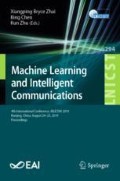Abstract
Wireless powered communication (WPC) is able to provide the wireless devices (WDs) practically infinite energy for information transmission, by deploying multiple power beacons (PBs) as dedicated energy source. The performance of wireless energy transfer and wireless information transmission may significantly vary depending on the locations of the wireless nodes and the channels used for signal transmission. To enable efficient transmission and overcome the doubly-near-far problem in WPC, this paper proposes a PB deployment strategy where the distribution of PBs is subject to a truncated Poisson cluster process (PCP), and analytically investigates the performance of WPC in terms of the SNR outage probability. Specifically, we consider a harvest-then-transmit communication network, where WDs use RF harvested energy for the information transmission in each time block. The wireless energy transfer between WDs and PBs is achieved by either directed mode (WD is served by the closed PB) or isotropic mode (WD is served by multiple PBs). We first investigate the distribution of the distance between WD and an arbitrary PB in the associated cluster. Then, we derive a numerically computable form of the SNR outage probability for directed mode and a tight upper bound of the SNR outage probability for isotropic mode. Finally, numerical results verify the accuracy of the analytical results, present performance comparisons with varied network parameters, and reveal the advantages of the truncated PCP based PB deployment over the random PB deployment and the symmetric PB deployment.
This work was supported in part by the National Natural Science Foundation of China (No. 61701168, 61832005, 61571303) and the Fundamental Research Funds for the Central Universities (No. 2019B15614).
Access this chapter
Tax calculation will be finalised at checkout
Purchases are for personal use only
References
Huang, K., Zhou, X.: Cutting last wires for mobile communication by microwave power transfer. IEEE Commun. Mag. 53(6), 86–93 (2015)
Huang, K., Lau, V.K.N.: Enabling wireless power transfer in cellular networks: architecture, modeling and deployment. IEEE Trans. Wirel. Commun. 13(2), 902–912 (2014)
Zhong, C., Chen, X., Zhang, Z., Karagiannidis, G.K.: Wireless powered communications: performance analysis and optimization. IEEE Trans. Commun. 63(12), 5178–5190 (2015)
Huang, W., Chen, H., Li, Y., Vucetic, B.: On the performance of multi-antenna wireless-powered communications with energy beamforming. IEEE Trans. Veh. Technol. 65(3), 1801–1808 (2015)
Lee, S., Zhang, R., Huang, K.: Opportunistic wireless energy harvesting in cognitive networks. IEEE Trans. Wirel. Commun. 12(9), 4788–4799 (2013)
Han, K., Huang, K.: Wirelessly powered backscatter communication networks: modeling, coverage, and capacity. IEEE Trans. Wirel. Commun. 16(4), 2548–2561 (2017)
Chen, L., Wang, W., Zhang, C.: Stochastic wireless powered communication networks with truncated cluster point process. IEEE Trans. Veh. Technol. 66(12), 11286–11294 (2017)
Tabassum, H., Hossain, E., Ogundipe, A., Kim, D.I.: Wireless-powered cellular networks: key challenges and solution techniques. IEEE Commun. Mag. 53(6), 63–71 (2015)
Bi, S., Zhang, R.: Placement optimization of energy and information access points in wireless powered communication networks. IEEE Trans. Wirel. Commun. 15(3), 2351–2364 (2015)
Tabassum, H., Hossain, E.: On the deployment of energy sources in wireless-powered cellular networks. IEEE Trans. Commun. 63(9), 3391–3404 (2015)
Haenggi, M.: On distances in uniformly random networks. IEEE Trans. Inf. Theory 51(10), 3584–3586 (2005)
Afshang, M., Dhillon, H.: Poisson cluster process based analysis of Hetnets with correlated user and base station locations. IEEE Trans. Wirel. Commun. 17(4), 2417–2431 (2018)
Hemachandra, K.T., Beaulieu, N.C.: Outage analysis of opportunistic scheduling in dual-hop multiuser relay networks in the presence of interference. IEEE Trans. Commun. 61(5), 1786–1796 (2013)
Hayajneh, A.M., Zaidi, S.A.R., McLernon, D.C., Renzo, M.D., Ghogho, M.: Performance analysis of UAV enabled disaster recovery networks: a stochastic geometric framework based on cluster processes. IEEE Access 6, 26215–26230 (2018)
Author information
Authors and Affiliations
Corresponding author
Editor information
Editors and Affiliations
Appendix
Appendix
Let us denote the reference WD chosen uniformly at random in the representative cluster is located at origin. Without loss of generality, we assume the location of the AP in the cluster is denoted by \({\mathbf x}_o=(v,0)\), and the region where PB can be distributed is represented by \(A_{p}= B _p({\mathbf x}_o,r,R)\) (the shaded regions in Fig. 4). The expression of the CDF of the distance \(d_R\) is

where \( B (o,u)\) denotes the circle centered at origin with radius u (red circles in Fig. 4) and \(|\varXi |\) represents the area covered by any generic region \(\varXi \in \mathbb {R}^2\). The area of the joint region between \(A_{p}\) and \( B (o,u)\) can be computed for different configurations between r, R, u, and v. As shown in Fig. 4, when \(r\ge \frac{R}{3}\), with the increasing of v, four different configurations have to be considered and thus four varied piecewise function of \(F_{d_R}(u|v)\) can be derived. The similar characterization can be carried out for \(r<\frac{R}{3}\). Finally, the expressions of PDF of \(d_R\) is obtained by differentiating \(F_{d_R}(u|v)\) with respect to u.
Rights and permissions
Copyright information
© 2019 ICST Institute for Computer Sciences, Social Informatics and Telecommunications Engineering
About this paper
Cite this paper
Zhou, S., Zhao, J., Tan, G., Li, X., Yan, Q. (2019). Power Beacons Deployment in Wireless Powered Communication with Truncated Poisson Cluster Process. In: Zhai, X., Chen, B., Zhu, K. (eds) Machine Learning and Intelligent Communications. MLICOM 2019. Lecture Notes of the Institute for Computer Sciences, Social Informatics and Telecommunications Engineering, vol 294. Springer, Cham. https://doi.org/10.1007/978-3-030-32388-2_29
Download citation
DOI: https://doi.org/10.1007/978-3-030-32388-2_29
Published:
Publisher Name: Springer, Cham
Print ISBN: 978-3-030-32387-5
Online ISBN: 978-3-030-32388-2
eBook Packages: Computer ScienceComputer Science (R0)


